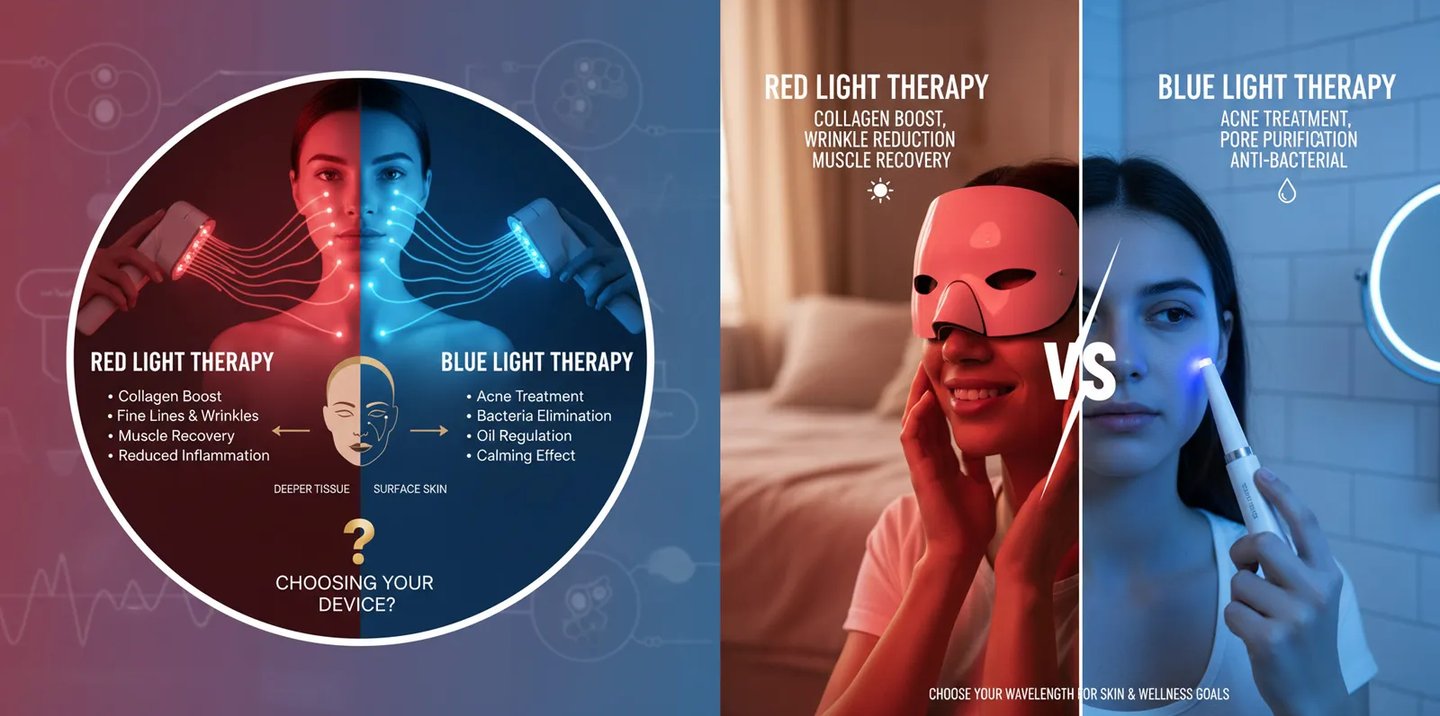Becoming the world's leading health appliance brand, bringing "professional physiotherapy home," and making a healthy life easily accessible.
Red Light vs Blue Light Therapy: Key Differences, Benefits, and Best Uses
Discover the difference between red light therapy and blue light therapy. Learn how each wavelength works, its unique benefits, and how to choose the right LED light therapy device for your skin and wellness goals.
PHOTOTHERAPY BASICS > POPULAR SCIENCE EDITION
YEEQO
11/3/20252 min read


1. What Is Light Therapy?
Light therapy, also known as Photobiomodulation (PBM), uses specific wavelengths of visible light to stimulate cellular activity and promote natural healing. Among various wavelengths, red light and blue light therapy are the most widely used in cosmetic and dermatological treatments. Understanding their differences is key to achieving your specific skincare goals.
2. Red Light Therapy: Deep Repair and Anti-Aging
Red light therapy typically ranges from 630nm to 660nm, often combined with near-infrared light (around 850nm). Due to its longer wavelength, it penetrates deep into the dermis and muscle tissue.
Main Benefits:
✅Boosts collagen production to improve skin elasticity and reduce wrinkles.
✅Accelerates cell repair by enhancing mitochondrial energy metabolism.
✅Reduces inflammation and pain, ideal for muscle and joint recovery.
✅Improves blood circulation and promotes overall skin rejuvenation.
Best for: Anti-aging skincare, post-treatment recovery, and deep tissue relaxation.
3. Blue Light Therapy: Acne Control and Surface Purification
Blue light therapy operates in the 415nm–470nm wavelength range. Its shorter wavelength means it primarily targets the surface layer of the skin (epidermis).
Main Benefits:
✅**Kills acne-causing bacteria** (Propionibacterium acnes) by targeting porphyrins.
✅Regulates sebum production, which is beneficial for oily skin types.
✅Reduces surface inflammation and helps calm minor redness associated with breakouts.
Best for: Acne-prone, oily, or inflamed skin types.
4. Comparison Table: Red vs Blue Light
Feature Red Light Therapy Blue Light Therapy
Wavelength 630–660nm (with 850nm NIR) 415–470nm
Penetration Depth Deep (Dermis & Tissue) Surface (Epidermis)
Key Benefit Repair, Rejuvenation, Circulation Acne Control, Antibacterial
Skin Feel Warm and Soothing Cool and Calming
Ideal Users Aging or Dull Skin Oily or Acne-Prone Skin
5. How to Use Light Therapy Safely
Regardless of the color you choose, safe usage is paramount for positive results:
🔹**Define your goal** – Choose red light for deep repair, blue light for acne, or a combined setting for holistic care.
🔹**Follow routine sessions** – Maintain 10–20 minutes per session, 3–5 times weekly, for best results.
🔹**Use certified devices** – Choose FDA-approved or CE-certified LED devices (like YEEQO Light Therapy Panels) for reliable wavelength output.
🔹**Avoid overexposure** – More light is not always better; follow the recommended distance and duration guidelines.
6. Conclusion: The Power of Targeted Light
Both red and blue light therapies offer unique, scientifically validated benefits for skin health. Red light rejuvenates from within, while blue light purifies the surface.
When used correctly, light therapy becomes a safe and effective tool for achieving clear, youthful, and balanced skin.
YEEQO
© 2025 YEEQO Health Appliances. All rights reserved.
